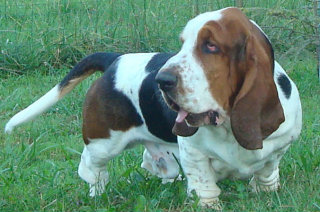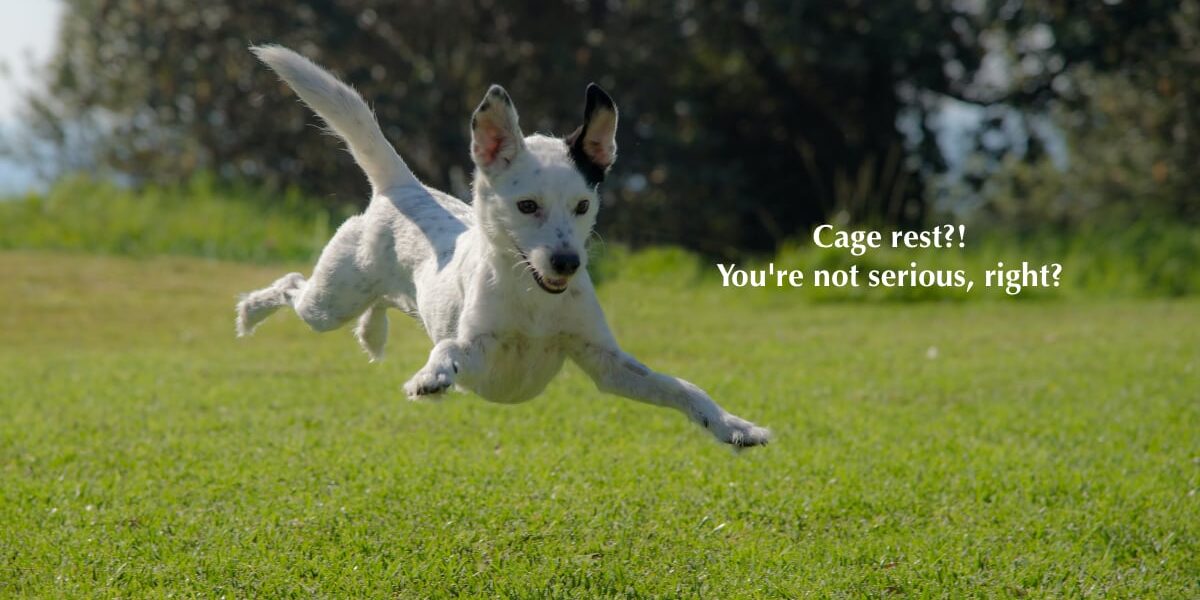Feed Pets Food Like Their Ancestors Ate
Stop Killing Your Pet: The Top 5 Ways -- Part Two
The food you offer your pet is entirely up to you as chief caretaker. And yet, part of your animal “remembers” what’s appropriate to eat, and you, as her caretaker, have to find your way through the maze of choices and ideally match that “memory” of the perfect food with your offering.
Big responsibility. They “are what they eat,” and you want to make good choices here. Your animal’s health and longevity depend on your choices.
When you do the feeding wrong, you are killing your pet. Slowly, sure, but that's the direction, away from Vital.
The Context You Make Choices In
We live in a trendy, market driven society. A society where, at least for the last 60 years, you’ve been bombarded with advertisers making claims and offering up catchy jingles and slogans in order to influence your purchasing decisions.
That’s slowly changing, but you’ll do well to push that curve and outthink the marketing hype when you buy natural pet food. Or, not "buy" it at all.
Who’s That Circling the Food Dish?
The truth is, if you’re feeding a dog, you have a modern day wolf getting excited around feeding time (or maybe not excited, depending partly on what you're offering).
Recent studies have matched some 99% of the domestic dog’s genes with those of the wolf. Your pooch, what ever breed or mix she is, has the digestive system (and food needs) of the wolf.
Can you imagine your cat as lynx or bobcat as well? Easy, right? The “domesticated” (ha!) cat, similar to her wild ancestors, is clearly built like a hunting machine. From her sharp, pointed teeth and claws to her raspy tongue made to lick meat from bones, she’s clearly showing her wild inheritance through and through.
The important point is not to confuse the cutest modern versions of the wolf or lynx who live with you as somehow “changed” digestively. They are not.
Bred for Appearance. Only.
The cute or otherwise non-wild look of our modern dogs and cats is the result of mankind’s genetic selection. Selection for only that: appearance.
Society has decided, over the past tiny fraction of time (100 years or so) that certain features in domestic dogs and cats are “desirable” and likely to be purchased.
We like the cute, round heads of dogs that resemble human babies.
To whit, the Cavalier King Charles Spaniel.
We might like the long, silky haired, short-nosed Persian or Himalayan cats.
In “voting with our wallets” for these appearances, entire breeds have been created and propagated. And boy, did we select some that looked different from the ancestors!
But, (and here’s where you’ve got to be a smart, thinking consumer),
We have not changed the digestive system of our pets from the wild model.
Not one iota.
Why? Because we (or rightly, pet breeders) have not selected for anything other than appearance. And maybe behaviors, to a lesser extent.
You know, the loving, affectionate lap dog or cat companion who's in heaven being close to you and receiving your petting. "Oh, wait, don't stop!"
So, Whatcha Gonna Feed Your Wolf?
Cereal? Dried, manufactured, food like particles?
That's what you find in the pet food aisle of every grocery store. Every PetSmart, Petco, WalMart, etc. has a whole lot of shelf space given to this stuff. These foods fuel the multi-billion dollar pet food industry.
That’s billion, with a B.
Picture manufacturers, cheek by jowl racing pet foods to market, watching your wallet-voting behavior as they develop the next “100% Complete!” or “All Natural!” pet food for your wolf or lynx to eat.
“Now, With Antioxidants!” Or, it might be more subtle, with a gorgeous picture of a cornucopia of food on the label that looks amazingly delicious. And blueberries on the label (coming somewhere after zinc in the ingredient list!).
Or, will you choose something smarter, something more closely resembling ancestral food?
Your Food Choices Could Be Killing Your Pet
Kibble, the pelleted food-like particles so commonly sold for pets, are often a detriment to your wolf’s or lynx’s health. Even in those touted as natural, pet food often has two big problems.
- They are often toxic.
If the words “byproducts,” or “digest” are on the label, it means meat sources unfit for humans to eat.
Including the “4-D” meats. From Dead, Diseased, Dying, or Disabled/Downer animals who are condemned and rendered for pet food.
Who uses this horrible stuff? Common brands. Here’s a Science Diet prescription food's label for "Healthy Advantage":
Here's the first couple lines, highlighted for you:
- They are dead foods. Lifeless.
Remember that wolf you own? That lynx sprawled out on your bed?
They are genetically “remembering” and genetically “expecting” live food.
Because that’s what all the ancestors ate, who passed their digestive genes on to your pal who now lives in the house with you.
To overstate the obvious: Prey never runs into a fire before the predator eats it.
Most importantly, perhaps, they are manufactured and sold based on myth. Even most so-called natural pet foods.
When Myths Rule, Pets Die Early
The mother of all myths, especially prevalent since the post World War II days, is that “Science Knows Best.”
You know, the myth that we can solve all our problems and feed the world and kill all the pests with the right stew of chemicals and scientific know how.
That myth brought us
- Wheaties, The Breakfast of Champions, that leaves you hungry by mid-morning and insulin resistant long term.
- Hybridized wheat that yields record bushels per acre, but brings you inflammatory gluten that makes your joints ache and is incriminated in Chrohn’s, aka Inflammatory Bowel Disease.
- DDT that wiped out beneficial insects and birds of prey along with its intended target of bedbugs or mosquitoes.
How does that myth play out in your pet’s food dish?
It shows up in pet food like Science, sold by veterinarians, and trumpeting “100% Nutritionally Complete” on the label.
Did you know that untold cats have suffered or died of taurine deficiency related heart failure (and/or blindness) on food from this company (and others you know) that assured us it was 100% Nutritionally Complete? True.
The well respected journal, Science, in 1987, when this first came to light, opened the article with the words, “Thousands of pet cats die each year with dilated cardiomyopathy…”
The link was clearly made between diets supposedly 100% complete, but actually being taurine deficient, and causing disease and death in thousands of pets.
Oops.
The myth of Science Knows Best would also have you feeding just one factory made food with nothing added for the life of your animals.
Imagine hearing such advice from your pediatrician: “Offer only this formulated, prepared diet to your child, with nothing fresh added.” Would you do this for your child?
Of course not! You'd run to a another pediatrician in a heartbeat!
Survive vs. Thrive
Pets can live on these diets, certainly. They do all the time. But these foods don’t "Build Vital Animals Twelve Ways!" Or even one way. In fact, these foods create chronic ill health, and hasten death.
You want more than survival, presumably, or you wouldn’t be here.
To grow a vital animal, the secret is this:
Feed the Need.
The need is the call of wolf, the yowl of the lynx, the wild digestive system’s demand for Real Food.
Lumper that I am, I offer you two broad ways that you can answer the call of the wild, and help your animals to thrive:
- Buy it prepared, raw and balanced.
- Make it balanced with raw ingredients.
There are several choices out there for buying it ready made. This is easy and more costly than Way #2.
Here's some recommended training on how to make it at home. This is more work and cheaper than Way #1.
Final Stop: Stop Feeding the Same Thing Always.
Think about the predators in your home. Their ancestors never ate a mono diet.
When the caribou thinned out or moved off the wolf’s range, they moved to voles. Or rabbits. Or birds eggs. Day to day, choices varied.
You’ll do well to follow at least a monthly rotation of protein sources. Whether you buy or make your balanced raw food, change it up. You might do beef month, followed by turkey month, followed by lamb or venison or chicken. Then repeat the cycle.
Even supplements should be changed periodically. Adding some kelp for iodine? Give it a rest and add some shell fish for a while. Using salmon oil for those wonderful EFA’s? Try a mix of other fish oils that has no salmon in it as a rotation. Be creative, be smart.
Change is built in to the wild guys' diets. Follow that example for your vital animal to thrive.
In the comments, tell us what’s working for your vital animals. Do you feed prepared raw diets? Whose do you like? Do you find one person’s recipes easier and more sensible to you than the rest? Give us the scoop!
[Next up in this series: Stop Using Pesticides to Kill Fleas]








Dear dr. Falconer,
I’ve a 5 years old chihuahua girl that I tried to feed what I thought was a better dog food – ziwipeak wet food, about 2 years ago. I thought I introduced it slowly enough but she ended up being very sick ( vomiting, diarrhea, wouldn’t eat, even had some fresh blood in her poos few times ) after about a month when I was still mixing it with the horrible Royal canine she used to have before. It continued for about 2 months on and off, then it finally settled after I cooked her turkey with sweet potato. She’s now on Simpson’s wet food- organic turkey, duck and vegetables and doing fine but has a lot of gas and I can often hear her tummy making noises. I’d like to start her on raw food diet but don’t know how to start introducing it and also a bit afraid that I’ll upset her digestive system again. I’d be very greatful for your kind advice.
Kind regards Magda.
Hi Magda,
I’m sorry you’re little one has fallen into such straits. I can see that your food choices have little to do with this. Why? A normal adjustment to a new food should be finished in a BM or two, three max. And there wouldn’t be vomiting and loss of appetite or months of tinkering necessary.
So, what it tells me is that she’s got chronic disease, the commonest kind of disease on the planet, and usually closely associated with vaccinations. The best answer I know is to get a veterinary homeopath hired to get her cured.
If you visit this page on Apoquel, you’ll see a free report called Apoquel Alternatives. In it, I outline in detail how to find a good homeopathic vet to help you.
You’re not doing anything wrong. But curing chronic disease is rarely accomplished with diet alone, and it’s rarely DIY (do it yourself). When she’s cured, she’ll be able to eat anything w/o a problem, have no gas, and be healthy overall, even after treatment ceases.
Worth pursuing! And good luck. There’s a light at the end of this tunnel.
Many thanks for your advice Dr Falconer, I’m looking for a holistic vet in our area to see what can be done.
Kind regards
Magda
This is a great article, Dr. Falconer!
I really appreciate Tricia’s post with the Danes as well. I am interested that you balance grain-containing Dr. Pitcairn recipes with this type of feeding. This looks like a good option that would defray some cost with large dogs, in a world full of extremists on this topic.
In an effort to do the best for my wolves, and stop spending $220/month on a pre-made dehydrated processed formula, I was ready to LEAP!
Daring to find out what this raw diet would cost as a DIY project made me hold my breath and do some math. Calculating for two, 50 pound active dogs, Finn and Loma was pretty enlightening. It is utterly amazing what math one can do if your wolves are depending on you to get it right!
If anyone needs help figuring out their dog’s math, let me know!
Taking the plunge, I bought a small 5 cubic foot chest freezer at Lowe’s for my apartment. Mentally, it was alot for me to realize how many pounds or animal products I needed to purchase, given that I eat very little meat.
SOURCING has been an eye-opening adventure into the world of all sorts of farming and meat production. I am tired! This adventure has taken me through options from Craigslist to conventional grocery stores to Whole Foods to local farmers with humanely raised animals to my own brothers who hunt. I am *still working on this part.
I could do this diet for much cheaper with factory farmed animals. The majority of people feeding raw do use conventionally raised meat, due to sheer volume needed to feed and cost.
I was getting suck in the muck given my budget and my strong beliefs about factory farming.
Ethically, I do not want to support that industry by voting with my dollar. After working in the “sick pen” in a conventional dairy as a vet tech about 5 years ago, I learned about those downer cows and all the things they do to factory cows. I already knew too much about feedlot beef and factory poultry.
I calculated totals per month between both dogs using a perfect-world standard (free range, grass fed/finished, locally farmed meats/organs/bones) with three approaches.
1.) “Prey-Model” most commonly consisting of 80% meat, 10% RMB, 10% organs
Per month I would need: 60# meat, 8# bones, 8# organ.
Total cost/month= $ 220-350.
2.) Dogs Naturally Magazine has a guideline of 50% RMB, 35% muscle, 15% organs.
Per month I would need: 25# meat, 37# bones, 11# organs
Total cost/month= $180-240.
3.) Dr. Dobias (Vancouver, BC holistic vet) had a free webinar on raw feeding and his formula was somewhere in the middle of these spectrums. He includes veggies at 25% of the diet for antioxidant value and pH effects. They can eat the same veggies I eat so they are not included below.
Per month I would need: 56# meat, 21# bones, 4# organs.
Total cost/month= $220-340
Right now, I am going with the DNM option and adding veggies. This is one of the most fascinating adventures and I’d love any feedback others might have. I hope this is helpful for those starting out, it has been worthwhile to learn.
Lizzy
Nice work, Lizzy! Sounds like you need a well deserved vacation now, after all the figuring.
I can’t see the “pH effects” being worthwhile in a dog or cat, so I tend to keep the veggies to close to what a wolf might get, after shaking the rumen contents of the caribou all over the ground before diving in. Maybe 10%?
I think you could be a math/sourcing consultant, having put all the thought into it that you did! Ready to hang out your shingle?
Thanks Dr. Falconer!
Yes, I need a vacation and my eyes are still crossed. Budgets make one work, as do hungry wolves!
Good point on veggies.
Everywhere I go, I keep my eyes peeled. I was at HEB today (they have a great organic produce selection), found their “natural” whole chicken…that word can be loaded. It was just about 1.65/pound for the whole bird.
I called HEB later with questions on the label. They sent me to their supplier in GA, who happens to be one of the few poultry suppliers that is American Humane approved…and antibiotic free and is also cage free. WOW, yes commercially farmed, BUT its a happy middle.
Sourcing never ends, suppliers are not always reliable, and I am not sure I can afford the pasture raised option all the time-I am going to find a way to get that kind of meat for alot less, SOMEHOW!
Funny part is I used to be terrible at math! I love sourcing and could totally see helping anyone else through this.
Hi, Dr Will!
I’ve read, many times, on your website, feeding RAW eggs to dogs (and cats!), but I have read on the internet, in many locations (and I also heard this from my former employer, who has a Masters in Holistic Nutrition), that RAW egg white has an antimicrobial protein called Avidin bound to its Biotin, which prevents mammals from utilizing the Biotin. And that cooking inactivates the Avidin. I’ve been feeding my three Whippets a boiled egg/day for about 7+ months, and their skins and coats have improved, though they were good before. What do you think about the link between Biotin and Avidin?
Hi Doria,
This is a very common misunderstanding that comes from feeding parts of foods. So, while the egg white may rob biotin, guess what’s got lots of biotin in it? The yolk! And, as you can guess, I’m not advocating feeding one without the other. Now, I’m guessing here, but I’d bet wolves wouldn’t separate the yolk and toss it, right 😉 ?
Whole, natural foods win. Fractionating is just man’s idea, and we put ourselves and our animals in jeopardy the more we think that way.
Thanks for airing this out. More people need to know this.
Yeah, whenever I drop an egg on the floor as I’m boxing them up, I have a mini-feeding frenzy with three little Whippet-Wolves lapping it up, sometimes shell and all! My guess is, if the Wolves had to make a choice between the white and the yolk, they’d eat the yolk first! Mine do!
Hi Dr.
I’ve done both kibble and raw for my 2 great danes and looking at it from just a logistical and financial perspective (I’m a business analyst by trade) I continually find that the raw is both easier and less expensive. The health benefits are the best reason to go raw but most folks get hung up on how to incorporate it into their lives.
I open a package and hand each dog a couple chicken quarters or slab of beef ribs . Done. No cleaning dishes, no brushing teeth. I alternate with Dr. Pitcairn recipes. For us, 1 recipe equals 1 day (4meals) so I’ll make 3 batches on a Saturday and freeze. The only cooking is the grains. 1 large pot – 40min and Done. For Travel – we find a grocery store meat counter, use my restaurant leftovers or they fast for 1 meal. Easy. The part I like the best is that each week I clean out the fridge of leftovers, wimpy carrots and that 1/2 eaten apple, nothing is wasted. It all goes to the dog recipes. My food dollar doesn’t end up in the trash can or compost pile. Once you know the ‘rules’ of balancing the diet you’ll see meals for your animals everywhere you look.
Financially its comprable to the “premium” kibble and even less expensive if you are able to buy meat in bulk at the store or co-op. This is where a chest freezer comes in handy. Admittedly my dogs rarely get organic meat due to cost. But sometimes I do find organic or hormone free on sale and I stock up like mad for both myself and the dogs. Even grocery store meat (human grade), is better than meat by-products.
A long post but what I wanted to get across is that its not difficult to feed fresh for the average pet owner. For the time it takes you to walk the dog, you could have a weeks worth of fresh made meals ready in the freezer. And I promise it won’t break the bank.
Tricia, thanks so much for this. I’ve been inspired by your raw feeding right along, and the fact that you compared prices as an analyst really adds to this discussion.
And yes on the organic. I find repeatedly, that the difference between feeding kibble and raw is vast, but the difference between feeding ordinary raw and organic raw is indiscernible. At least to my homeopathic eyes, I can’t tell a difference.
Fleas, I use natural products such as diamatatious earth outside and 20 power mule team borax inside and there are no fleas here. I adopted a great dane once from a breeder and the agreement we made together is never to give it heartworm preventative. If the dane was to ever have heartworms that I would take it to a holistic vet for treatment and she gave me his name. I have never had a dog with heartworm but I often wondered what was added to the affected dogs water to cure it of heartworms. I at that point never gave heartworm treatment to my dogs and luckily have never had a problem. I am so glad that your information was shared on f/b….
I wish all vets would adopt homeopathic approaches to our beloved pets, knock on wood all of mine are healthy.
Kathleen in Central Florida
Our closest holistic vet is in Summerfield his last name begins with a “W”….
Hi Kathleen,
Welcome! It sounds like you’re doing several things right, to be raising heartworm- and flea-free dogs in Florida. Bravo!
Vets convinced me to feed Hill’s Science Diet to my little corgi. I’ve never agreed, but they were convincing…recently I put her on raw foods. In two weeks her coat has totally chanaged..it’s soft and shiny. She’s not biting and chewing her body and making hot spots. She’s a new dog!! I’m sorry I was so stupid.
Amazing, isn’t it, Patricia? You’d think vets would be ultra careful and only recommend top quality foods, wouldn’t you?
But then, guess who “taught” us nutrition in vet school? And donated all the food, free, to the vet school teaching hospital?
Have to look deeper these days, to keep your animal vital and healthy.
Hi Dr. Falconer – I was wondering if you might address High Pressure Pasteurization in raw pets foods. I get my meat from the farmers market, but I think most people who buy their raw foods already prepared from pet stores may not be aware that some of those “raw” products are now doing the HPP. Plus they may not be aware of whether the HPP process has a detrimental or beneficial impact on the food and subsequently the health of their animal.
Thanks
Yes, good point, Roxanna. There’s even milk being foisted on the public here in Austin by a very large “organic” dairy that uses what they’ve termed, “low heat pasteurization.” When asked about it, it became clear that it was high enough to kill the enzymes in the raw, which is one of the most valuable reasons for eating/feeding raw products.
So, it’s always Buyer Beware in the market place. There’s a lot to watch out for, especially in the billion $$ “natural” food realm.
There’s also a lot of fear about “germs.” I speak to this in my Food Safety and Raw Meat page. If we think we need to pasteurize raw meat before we feed it, we’ve just lost most of its value!